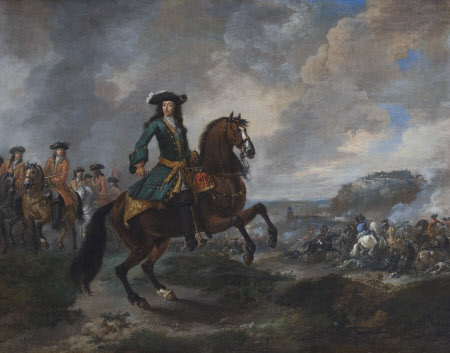King William III (William of Orange) (1650–1702) at the Second Seige of Namur, 2 July – 1 September 1695
Jan Wyck (Haarlem 1645 - Mortlake 1700)
Category
Art / Oil paintings
Date
1695 (after)
Materials
Oil on canvas
Measurements
762 x 991 mm (30 x 39 in)
Place of origin
England
Order this imageCollection
Mount Stewart, County Down
NT 1220971
Caption
When it was purchased by the Marchioness of Londonderry in 1954, this painting was thought to depict William III at the Battle of the Boyne in 1690. However, the scene is actually from the 1695 Siege of Namur, which took place during the Nine Years' War. This event saw the city retaken by the European coalition known as the 'Grand Alliance', following its capture by the French in 1692. The equestrian portrait in the foreground shows the English King posing triumphantly with his entourage while the battle rages behind him. The distinctive rocky outcrop and citadel of Namur can be seen in the distance. Jan Wyck painted many copies of this painting, but this is thought to be the prime version, once owned by William III. By 1743 it was in the collection of George Stone, Bishop of Kildare, from whom it is thought to have passed to Charles Moore, 1st Marquess of Drogheda, whose seal is still attached to the reverse.
Summary
Oil painting on canvas, King William III (William of Orange) (1650–1702) at the Second Seige of Namur, 2 July – 1 September 1695 by Jan Wyck (Haarlem 1645 – Mortlake 1700), signed, bottom left, in a flourish: J. Wyck [J W monogram]. William of Orange occupies the centre of the composition, seated on a chestnut horse. Other figures in his entourage include Colonel Byerley, wearing a red coat on the Byerley Turk to the left. The Byerley Turk (c.1684–1706) was the earliest of three stallions that were the founders of the modern thoroughbred horse racing bloodstock (the other two are the Godolphin Arabian and the Darley Arabian).The capture of the stallion is credited to Robert Byerley (1660 -1714) at the Battle of Buda (1686). He served as Byerley's war horse when he was dispatched to Ireland in 1689 during King William's War and saw further military service in the Battle of the Boyne in 1689. An identical composition is in the Cobbe Collection, Hatchlands (NT 1166189).
Provenance
According to the inscription beneath John Faber's 1743 mezzotint engraving of this painting, it was "once King William's now in the Hands of the Bishop of Kildare [George Stone, Bishop of Kildare, 1743-45]". A red seal of Moore Abbey, County Kildare (the country seat of Charles Moore, 1st Marquess of Drogheda) is affixed to the stretcher. On the back of the frame is a typed label which reads: "Bought from / H. Hamilton – Hunter, 47 Dawson Street / Dublin. 6th August 1954". It was brought to Mount Stewart by Edith Chaplin, Marchioness of Londonderry (1878-1959). The painting was given to the National Trust by Lady Mairi Bury (1921-2009) in 1976.
Credit line
Mount Stewart, The Londonderry Collection (National Trust)
Marks and inscriptions
Recto: J W [in a monogram] Verso: on the top member of the stretcher: in white: C1; in torn fragments, a green stencil: 3 [–?] 2; in pencil: No22 and 37; and a red seal, inscribed: MOORE ABBEY / [?]MONASTEREVEN; on the left member of the stretcher, in blue ink on a white octagonal label: WO/4674 Verso: on the upper member, in white: C1; on the bottom of the left member, on a round, white label, in blue ink: 605; and on a round, white, serrated label, in black ink: 89; on a typed label attached to the top member of the frame: Bought from / H. Hamilton – Hunter, 47 Dawson Street / Dublin. 6th August 1954 / Antique Oil Painting depicting King / William III with his staff at the Battle / of the Boyne, with a view of Oldtown / in the background. On canvas in old / frame, by Jan Wyck, Dutch, circa 1700. / Signed. / Ex-Collection of the Earl of Drogheda.
Makers and roles
Jan Wyck (Haarlem 1645 - Mortlake 1700), artist

